中医术语英译
- 格式:doc
- 大小:485.50 KB
- 文档页数:41
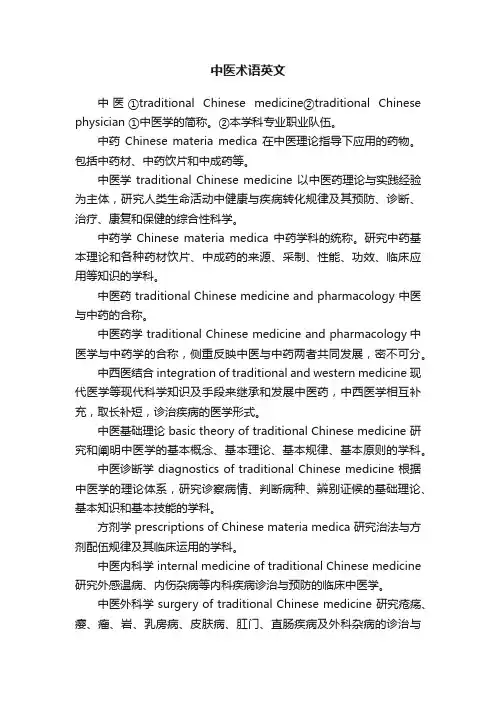
中医术语英文中医①traditional Chinese medicine②traditional Chinese physician ①中医学的简称。
②本学科专业职业队伍。
中药Chinese materia medica 在中医理论指导下应用的药物。
包括中药材、中药饮片和中成药等。
中医学traditional Chinese medicine 以中医药理论与实践经验为主体,研究人类生命活动中健康与疾病转化规律及其预防、诊断、治疗、康复和保健的综合性科学。
中药学Chinese materia medica 中药学科的统称。
研究中药基本理论和各种药材饮片、中成药的来源、采制、性能、功效、临床应用等知识的学科。
中医药 traditional Chinese medicine and pharmacology 中医与中药的合称。
中医药学 traditional Chinese medicine and pharmacology中医学与中药学的合称,侧重反映中医与中药两者共同发展,密不可分。
中西医结合 integration of traditional and western medicine 现代医学等现代科学知识及手段来继承和发展中医药,中西医学相互补充,取长补短,诊治疾病的医学形式。
中医基础理论 basic theory of traditional Chinese medicine 研究和阐明中医学的基本概念、基本理论、基本规律、基本原则的学科。
中医诊断学 diagnostics of traditional Chinese medicine 根据中医学的理论体系,研究诊察病情、判断病种、辨别证候的基础理论、基本知识和基本技能的学科。
方剂学 prescriptions of Chinese materia medica 研究治法与方剂配伍规律及其临床运用的学科。
中医内科学 internal medicine of traditional Chinese medicine 研究外感温病、内伤杂病等内科疾病诊治与预防的临床中医学。
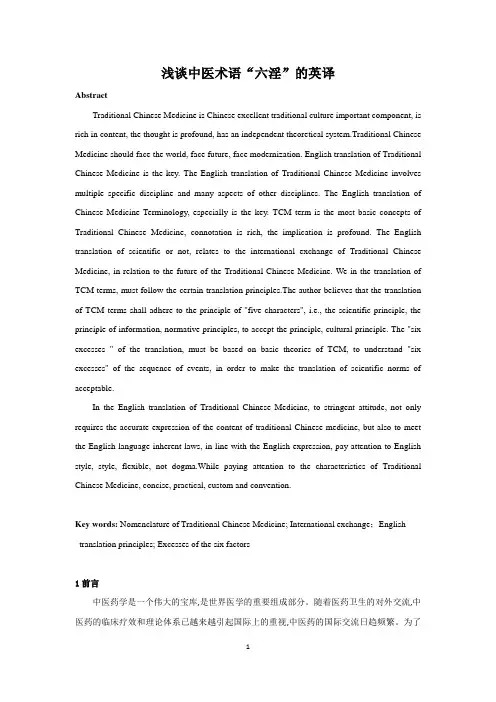
浅谈中医术语“六淫”的英译AbstractTraditional Chinese Medicine is Chinese excellent traditional culture important component, is rich in content, the thought is profound, has an independent theoretical system.Traditional Chinese Medicine should face the world, face future, face modernization. English translation of Traditional Chinese Medicine is the key. The English translation of Traditional Chinese Medicine involves multiple specific discipline and many aspects of other disciplines. The English translation of Chinese Medicine Terminology, especially is the key. TCM term is the most basic concepts of Traditional Chinese Medicine, connotation is rich, the implication is profound. The English translation of scientific or not, relates to the international exchange of Traditional Chinese Medicine, in relation to the future of the Traditional Chinese Medicine. We in the translation of TCM terms, must follow the certain translation principles.The author believes that the translation of TCM terms shall adhere to the principle of "five characters", i.e., the scientific principle, the principle of information, normative principles, to accept the principle, cultural principle. The "six excesses " of the translation, must be based on basic theories of TCM, to understand "six excesses" of the sequence of events, in order to make the translation of scientific norms of acceptable.In the English translation of Traditional Chinese Medicine, to stringent attitude, not only requires the accurate expression of the content of traditional Chinese medicine, but also to meet the English language inherent laws, in line with the English expression, pay attention to English style, style, flexible, not dogma.While paying attention to the characteristics of Traditional Chinese Medicine, concise, practical, custom and convention.Key words: Nomenclature of Traditional Chinese Medicine; International exchange;English translation principles; Excesses of the six factors1前言中医药学是一个伟大的宝库,是世界医学的重要组成部分。
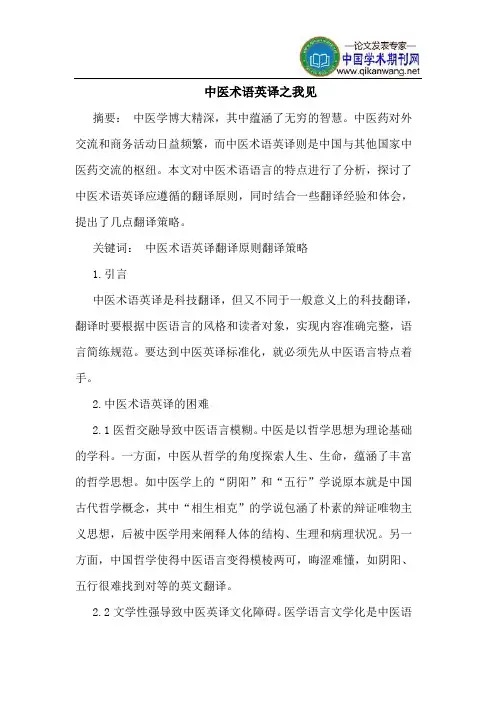
中医术语英译之我见摘要:中医学博大精深,其中蕴涵了无穷的智慧。
中医药对外交流和商务活动日益频繁,而中医术语英译则是中国与其他国家中医药交流的枢纽。
本文对中医术语语言的特点进行了分析,探讨了中医术语英译应遵循的翻译原则,同时结合一些翻译经验和体会,提出了几点翻译策略。
关键词:中医术语英译翻译原则翻译策略1.引言中医术语英译是科技翻译,但又不同于一般意义上的科技翻译,翻译时要根据中医语言的风格和读者对象,实现内容准确完整,语言简练规范。
要达到中医英译标准化,就必须先从中医语言特点着手。
2.中医术语英译的困难2.1医哲交融导致中医语言模糊。
中医是以哲学思想为理论基础的学科。
一方面,中医从哲学的角度探索人生、生命,蕴涵了丰富的哲学思想。
如中医学上的“阴阳”和“五行”学说原本就是中国古代哲学概念,其中“相生相克”的学说包涵了朴素的辩证唯物主义思想,后被中医学用来阐释人体的结构、生理和病理状况。
另一方面,中国哲学使得中医语言变得模棱两可,晦涩难懂,如阴阳、五行很难找到对等的英文翻译。
2.2文学性强导致中医英译文化障碍。
医学语言文学化是中医语言特点之一。
许多中医经典著作都以文言写成,其文体包含歌咏、诗赋等,语言具有浓厚的古典文学特点。
因此,中医英译时常面临以下两方面困难:一方面中医和西医的文化背景有很大区别,另一方面中医中的一些治疗方法和技巧很难让西方人理解,甚至造成误解。
3.中医术语英译的翻译原则针对中医英译的困难,中医英译时应遵循忠实、准确、统一的原则。
3.1“忠实”原则。
这指正确地将原文语言的信息用译文语言表达出来,不苛求语法与句子结构的一致,却要求信息内涵的对等。
奈达关于顺乎自然的对等的论述,同样适用于中医英译。
中医理论中有一些概念,如阴阳、五行、藏象等,具有典型的中国文化特色。
因此,中医术语英译是向读者传达的是中国古老的医学科学知识,译者应遵循实事求是的原则。
如“上古圣人之教下也,皆谓之虚邪贼风”的“贼风”是指引起人伤风感冒的致病因素,即可翻译为现代的医学术语pathogen,无须为了保持外国人并不能欣赏的古典文学及哲学而生硬地翻译为thief wind。
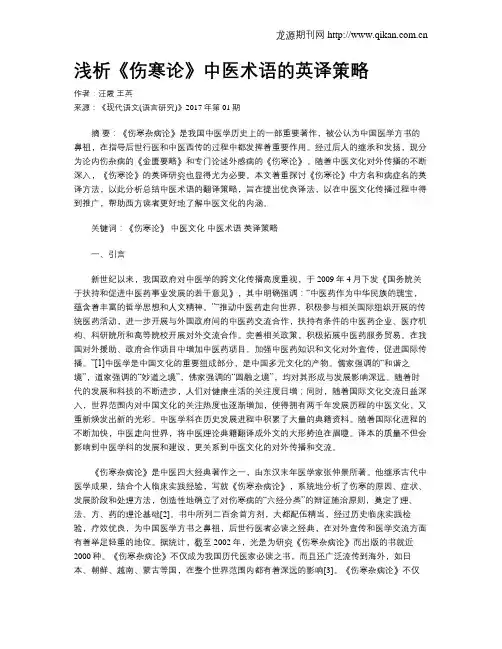
浅析《伤寒论》中医术语的英译策略作者:汪霞王英来源:《现代语文(语言研究)》2017年第01期摘要:《伤寒杂病论》是我国中医学历史上的一部重要著作,被公认为中国医学方书的鼻祖,在指导后世行医和中医西传的过程中都发挥着重要作用。
经过后人的继承和发扬,现分为论内伤杂病的《金匮要略》和专门论述外感病的《伤寒论》。
随着中医文化对外传播的不断深入,《伤寒论》的英译研究也显得尤为必要。
本文着重探讨《伤寒论》中方名和病症名的英译方法,以此分析总结中医术语的翻译策略,旨在提出优良译法,以在中医文化传播过程中得到推广,帮助西方读者更好地了解中医文化的内涵。
关键词:《伤寒论》中医文化中医术语英译策略一、引言新世纪以来,我国政府对中医学的跨文化传播高度重视,于2009年4月下发《国务院关于扶持和促进中医药事业发展的若干意见》,其中明确强调:“中医药作为中华民族的瑰宝,蕴含着丰富的哲学思想和人文精神。
”“推动中医药走向世界,积极参与相关国际组织开展的传统医药活动,进一步开展与外国政府间的中医药交流合作,扶持有条件的中医药企业、医疗机构、科研院所和高等院校开展对外交流合作。
完善相关政策,积极拓展中医药服务贸易。
在我国对外援助、政府合作项目中增加中医药项目。
加强中医药知识和文化对外宣传,促进国际传播。
”[1]中医学是中国文化的重要组成部分,是中国多元文化的产物。
儒家强调的“和谐之境”,道家强调的“妙道之境”,佛家强调的“圆融之境”,均对其形成与发展影响深远。
随着时代的发展和科技的不断进步,人们对健康生活的关注度日增;同时,随着国际文化交流日益深入,世界范围内对中国文化的关注热度也逐渐增加,使得拥有两千年发展历程的中医文化,又重新焕发出新的光彩。
中医学科在历史发展进程中积累了大量的典籍资料。
随着国际化进程的不断加快,中医走向世界,将中医理论典籍翻译成外文的大形势迫在眉睫。
译本的质量不但会影响到中医学科的发展和建设,更关系到中医文化的对外传播和交流。
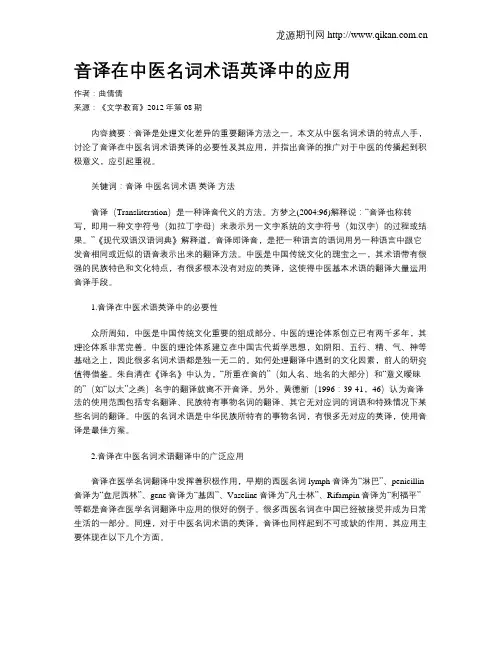
音译在中医名词术语英译中的应用作者:曲倩倩来源:《文学教育》2012年第08期内容摘要:音译是处理文化差异的重要翻译方法之一。
本文从中医名词术语的特点入手,讨论了音译在中医名词术语英译的必要性及其应用,并指出音译的推广对于中医的传播起到积极意义,应引起重视。
关键词:音译中医名词术语英译方法音译(Transliteration)是一种译音代义的方法。
方梦之(2004:96)解释说:“音译也称转写,即用一种文字符号(如拉丁字母)来表示另一文字系统的文字符号(如汉字)的过程或结果。
”《现代双语汉语词典》解释道,音译即译音,是把一种语言的语词用另一种语言中跟它发音相同或近似的语音表示出来的翻译方法。
中医是中国传统文化的瑰宝之一,其术语带有很强的民族特色和文化特点,有很多根本没有对应的英译,这使得中医基本术语的翻译大量运用音译手段。
1.音译在中医术语英译中的必要性众所周知,中医是中国传统文化重要的组成部分,中医的理论体系创立已有两千多年,其理论体系非常完善。
中医的理论体系建立在中国古代哲学思想,如阴阳、五行、精、气、神等基础之上,因此很多名词术语都是独一无二的。
如何处理翻译中遇到的文化因素,前人的研究值得借鉴。
朱自清在《译名》中认为,“所重在音的”(如人名、地名的大部分)和“意义暧昧的”(如“以太”之类)名字的翻译就离不开音译。
另外,黄德新(1996:39-41,46)认为音译法的使用范围包括专名翻译、民族特有事物名词的翻译、其它无对应词的词语和特殊情况下某些名词的翻译。
中医的名词术语是中华民族所特有的事物名词,有很多无对应的英译,使用音译是最佳方案。
2.音译在中医名词术语翻译中的广泛应用音译在医学名词翻译中发挥着积极作用,早期的西医名词lymph 音译为“淋巴”、penicillin 音译为“盘尼西林”、gene音译为“基因”、Vaseline音译为“凡士林”、Rifampin音译为“利福平”等都是音译在医学名词翻译中应用的很好的例子。
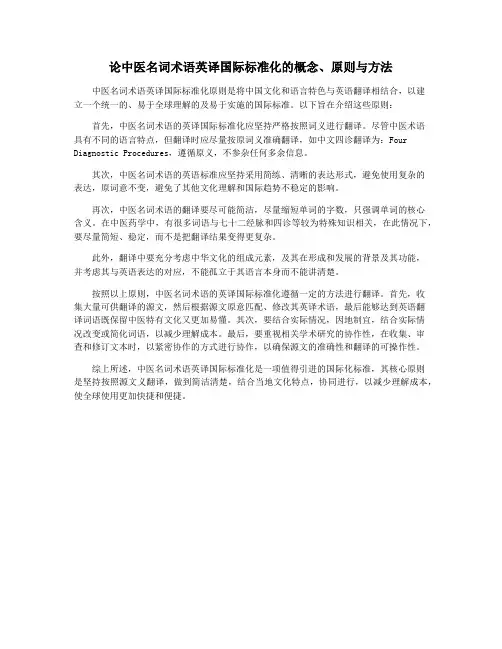
论中医名词术语英译国际标准化的概念、原则与方法中医名词术语英译国际标准化原则是将中国文化和语言特色与英语翻译相结合,以建立一个统一的、易于全球理解的及易于实施的国际标准。
以下旨在介绍这些原则:首先,中医名词术语的英译国际标准化应坚持严格按照词义进行翻译。
尽管中医术语具有不同的语言特点,但翻译时应尽量按原词义准确翻译,如中文四诊翻译为:Four Diagnostic Procedures,遵循原义,不参杂任何多余信息。
其次,中医名词术语的英语标准应坚持采用简练、清晰的表达形式,避免使用复杂的表达,原词意不变,避免了其他文化理解和国际趋势不稳定的影响。
再次,中医名词术语的翻译要尽可能简洁,尽量缩短单词的字数,只强调单词的核心含义。
在中医药学中,有很多词语与七十二经脉和四诊等较为特殊知识相关,在此情况下,要尽量简短、稳定,而不是把翻译结果变得更复杂。
此外,翻译中要充分考虑中华文化的组成元素,及其在形成和发展的背景及其功能,并考虑其与英语表达的对应,不能孤立于其语言本身而不能讲清楚。
按照以上原则,中医名词术语的英译国际标准化遵循一定的方法进行翻译。
首先,收集大量可供翻译的源文,然后根据源文原意匹配、修改其英译术语,最后能够达到英语翻译词语既保留中医特有文化又更加易懂。
其次,要结合实际情况,因地制宜,结合实际情况改变或简化词语,以减少理解成本。
最后,要重视相关学术研究的协作性,在收集、审查和修订文本时,以紧密协作的方式进行协作,以确保源文的准确性和翻译的可操作性。
综上所述,中医名词术语英译国际标准化是一项值得引进的国际化标准,其核心原则是坚持按照源文义翻译,做到简洁清楚,结合当地文化特点,协同进行,以减少理解成本,使全球使用更加快捷和便捷。
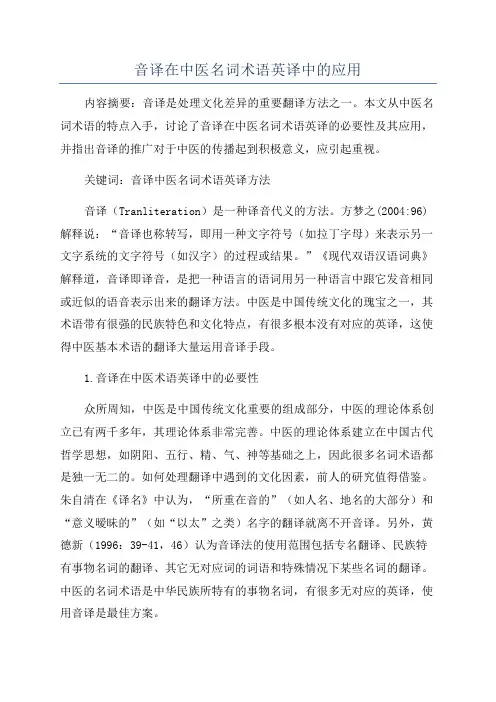
音译在中医名词术语英译中的应用内容摘要:音译是处理文化差异的重要翻译方法之一。
本文从中医名词术语的特点入手,讨论了音译在中医名词术语英译的必要性及其应用,并指出音译的推广对于中医的传播起到积极意义,应引起重视。
关键词:音译中医名词术语英译方法音译(Tranliteration)是一种译音代义的方法。
方梦之(2004:96)解释说:“音译也称转写,即用一种文字符号(如拉丁字母)来表示另一文字系统的文字符号(如汉字)的过程或结果。
”《现代双语汉语词典》解释道,音译即译音,是把一种语言的语词用另一种语言中跟它发音相同或近似的语音表示出来的翻译方法。
中医是中国传统文化的瑰宝之一,其术语带有很强的民族特色和文化特点,有很多根本没有对应的英译,这使得中医基本术语的翻译大量运用音译手段。
1.音译在中医术语英译中的必要性众所周知,中医是中国传统文化重要的组成部分,中医的理论体系创立已有两千多年,其理论体系非常完善。
中医的理论体系建立在中国古代哲学思想,如阴阳、五行、精、气、神等基础之上,因此很多名词术语都是独一无二的。
如何处理翻译中遇到的文化因素,前人的研究值得借鉴。
朱自清在《译名》中认为,“所重在音的”(如人名、地名的大部分)和“意义暧昧的”(如“以太”之类)名字的翻译就离不开音译。
另外,黄德新(1996:39-41,46)认为音译法的使用范围包括专名翻译、民族特有事物名词的翻译、其它无对应词的词语和特殊情况下某些名词的翻译。
中医的名词术语是中华民族所特有的事物名词,有很多无对应的英译,使用音译是最佳方案。
2.音译在中医名词术语翻译中的广泛应用音译在医学名词翻译中发挥着积极作用,早期的西医名词lymph音译为“淋巴”、penicillin音译为“盘尼西林”、gene音译为“基因”、Vaeline音译为“凡士林”、Rifampin音译为“利福平”等都是音译在医学名词翻译中应用的很好的例子。
很多西医名词在中国已经被接受并成为日常生活的一部分。
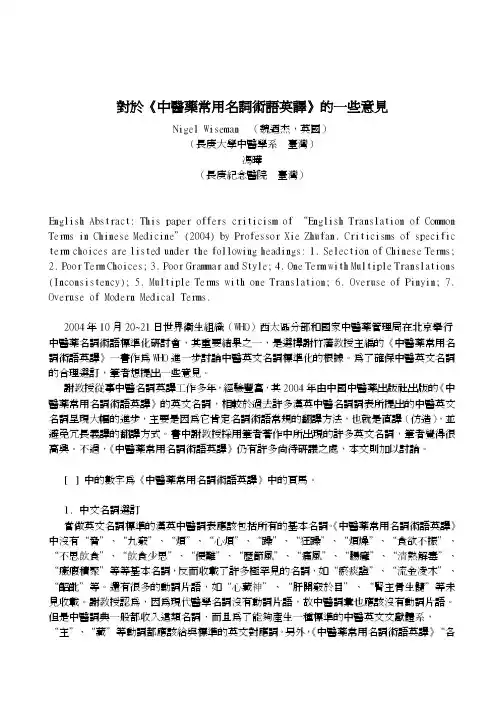
對於《中醫藥常用名詞術語英譯》的一些意見Nigel Wiseman (魏迺杰,英國)(長庚大學中醫學系 臺灣)馮曄(長庚紀念醫院 臺灣)English Abstract: This paper offers criticism of “English Translation of Common Terms in Chinese Medicine"(2004) by Professor Xie Zhufan. Criticisms of specific term choices are listed under the following headings: 1. Selection of Chinese Terms;2. Poor Term Choices;3. Poor Grammar and Style;4. One Term with Multiple Translations (Inconsistency);5. Multiple Terms with one Translation;6. Overuse of Pinyin;7. Overuse of Modern Medical Terms.2004年10月20~21日世界衛生組織(WHO)西太區分部和國家中醫藥管理局在北京舉行中醫藥名詞術語標準化研討會,其重要結果之一,是選擇謝竹藩教授主編的《中醫藥常用名詞術語英譯》一書作為WHO進一步討論中醫英文名詞標準化的根據。
為了確保中醫英文名詞的合理選訂,筆者想提出一些意見。
謝教授從事中醫名詞英譯工作多年,經驗豐富,其2004年由中國中醫藥出版社出版的《中醫藥常用名詞術語英譯》的英文名詞,相較於過去許多漢英中醫名詞詞表所提出的中醫英文名詞呈現大幅的進步,主要是因為它肯定名詞術語常規的翻譯方法,也就是直譯(仿造),並避免冗長義譯的翻譯方式。
書中謝教授採用筆者著作中所出現的許多英文名詞,筆者覺得很高興。
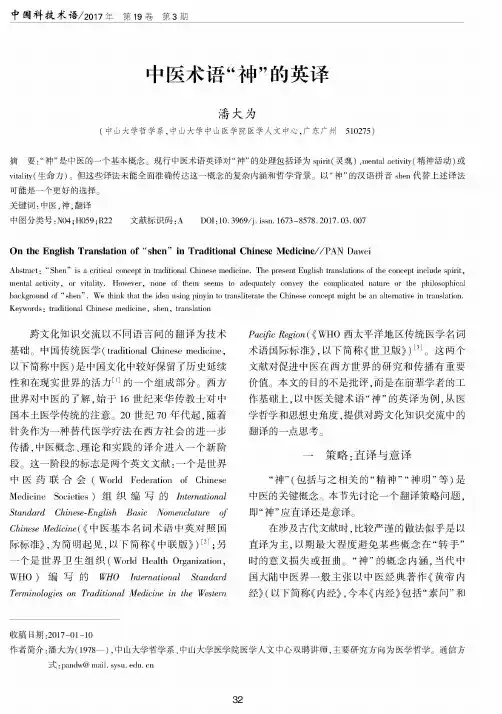
中国科技术语/2017年第19卷第3期中医术语“神”的英译潘大为(中山大学哲学系,中山大学中山医学院医学人文中心,广东广州510275)摘要:“神”是中医的一个基本概念。
现行中医术语英译对“神”的处理包括译为spirit(灵魂)、mental activity(精神活动)或 vitality(生命力)。
但这些译法未能全面准确传达这一概念的复杂内涵和哲学背景。
以“神”的汉语拼音shen代替上述译法 可能是一个更好的选择。
关键词:中医,神,翻译中图分类号:N04;H059;R22 文献标识码:A DOI: 10. 3969/j. issn. 1673-8578.2017. 03. 007On the English Translation of “shen 冶in Traditional Chinese Medicine//PAN DaweiAbstract: “Shen冶is a critical concept in traditional Chinese medicine. The present English translations of the concept include spirit, mental activity, or vitality. However, none of them seems to adequately convey the complicated nature or the philosophical background of “ shen冶.We think that the idea using pinyin to transliterate the Chinese concept might be an alternative in translation. Keywords: traditional Chinese medicine, shen, translation跨文化知识交流以不同语言间的翻译为技术 基础。
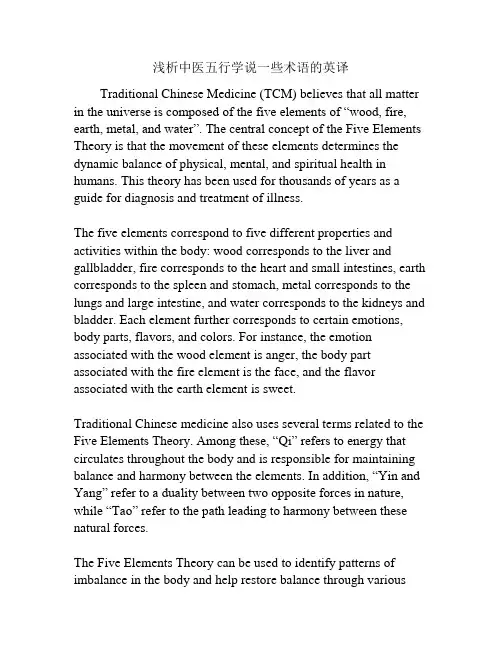
浅析中医五行学说一些术语的英译Traditional Chinese Medicine (TCM) believes that all matter in the universe is composed of the five elements of “wood, fire, earth, metal, and water”. The central concept of the Five Elements Theory is that the movement of these elements determines the dynamic balance of physical, mental, and spiritual health in humans. This theory has been used for thousands of years as a guide for diagnosis and treatment of illness.The five elements correspond to five different properties and activities within the body: wood corresponds to the liver and gallbladder, fire corresponds to the heart and small intestines, earth corresponds to the spleen and stomach, metal corresponds to the lungs and large intestine, and water corresponds to the kidneys and bladder. Each element further corresponds to certain emotions, body parts, flavors, and colors. For instance, the emotion associated with the wood element is anger, the body part associated with the fire element is the face, and the flavor associated with the earth element is sweet.Traditional Chinese medicine also uses several terms related to the Five Elements Theory. Among these, “Qi” refers to energy that circulates throughout the body and is responsible for maintaining balance and harmony between the elements. In addi tion, “Yin and Yang” refer to a duality between two opposite forces in nature, while “Tao” refer to the path leading to harmony between these natural forces.The Five Elements Theory can be used to identify patterns of imbalance in the body and help restore balance through variousforms of treatment. For example, when the wood element is out of balance, there might be feelings of anger or irritability, along with physical symptoms in the liver, gallbladder, or eyes. By applying treatments such as acupuncture, herbal medicines, or dietary modifications to target the wood element, balance can be restored. In conclusion, the Five Elements Theory is an important part of Traditional Chinese Medicine, and its terms, concepts, and applications have had a long-standing impact on many aspects of healthcare. By understanding the principles behind this powerful ancient healing system, practitioners can use it to help bring balance and health to their patients.。
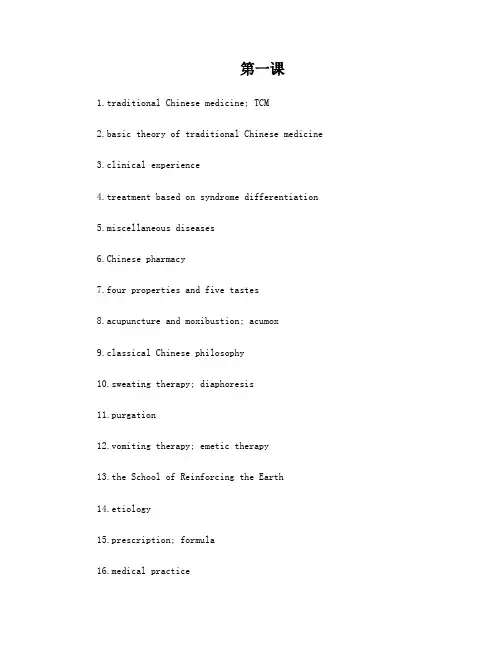
第一课1.traditional Chinese medicine; TCM2.basic theory of traditional Chinese medicine3.clinical experience4.treatment based on syndrome differentiation5.miscellaneous diseases6.Chinese pharmacy7.four properties and five tastes8.acupuncture and moxibustion; acumox9.classical Chinese philosophy10.sweating therapy; diaphoresis11.purgation12.vomiting therapy; emetic therapy13.the School of Reinforcing the Earth14.etiology15.prescription; formula16.medical practice17.therapeutic principles18.herbs cold and cool in nature19.nourishing yin and reducing fire20.diseases caused by blood stagnation一.句子翻译1.TCM has a history of thousands of years and is a summary of the Chinese people’s experiencein their struggle against diseases.2.TCM has a unique and integrated theoretical system.3.TCM is a science that studies the rules of life as well as the occurrence, progress, preventionand treatment of diseases.4.Yellow Emperor’s Canon of Medicine has laid a solid foundation for the formation oftheoretical system of traditional Chinese medicine.5.Classic of Difficulties has supplemented what was unaddressed in the Yellow Emperor’s Canonof Medicine in many respects, especially in pulse lore.6.Discussion on the Causes and Symptoms of Various Diseases is the earliest extant monographon the causes and symptoms of diseases in China.7.Yang is usually excessive while yin is frequently deficient.8.Internal impairment of the spleen and stomach causes various diseases.pendium of Materia Medica is recognized as a monumental workin the history of Chinesemateria medica and a great contribution to the development of pharmacology in the world.10.Traditional Chinese materia medica includes not only medicinal herbs, but also minerals andanimal parts.11.In the Jin and Yuan Dynasties, there appeared the so-called four great medical schools.12.Zhang Congzheng believed that all diseases were caused by exogenous pathogenic factors andadvocated that pathogenic factors should be driven out by means of diaphoresis, emesis and purgation.13.Liu Wansu believed that “fire-heat” was the main cause of a variety of diseases and thatthese diseases should should be treated with drugs cold and cool in nature.14.Li Gao held that “internal impairment of the spleen and stomach would bring about diseases”and emphasized that the most important thing in clinical treatment was to warm and invigorate the spleen and stomach.15.Zhu Danxi b elieved that “yang is usually excessive while yin is frequently deficient” andadvocated the remedies of nourishing yin and reducing fire in treatment of diseases. 16.Study on Warm Disease is a clinical specialty focusing on the occurrence, progress, diagnosisand treatment of warm diseases.17.The School of Warm Disease has developed the rules of treatment of warm disease based onsyndrome differentiation in light of defensive phase, qi phase, nutritive phase, blood phase and triple energizer.18.Wang Qingren in the late Qing Dynasty corrected mistakes about anatomy made in ancient medicalbooks and advocated the theory that diseases were caused by blood stagnation.19.Integrated traditional Chinese and Western medicine has paved a new way for the developmentand modernization of traditional Chinese medicine.20.Great progress has been made in systematic and experimental study of the basic theory oftraditional Chinese medicine.第二课1.five zang-organs; five zang-viscera2.six fu-organs3.system of meridians and collaterals4.holismanic wholenss6.social attribute7.(of the five zang-organs) open into8.sprout, grow, transform, ripen and store9.diagnostics10.relationship between pathogenic factors and healthy qi11.therapeuticsmon cold due to wind and cold13.different therapeutic methods used to treat the same disease14.the same therapeutic method used to treat different diseases15.balance of water metabolism16.clearing away heart fire17.nature of disease18.treating the left side for curing diseases located on the right side19.drawing yang from yin20.treating the lower part for curing diseases located on the upper part一.句子翻译1.The theoretical system of TCM is mainly characterized by holism and treatment based onsyndrome differentiation.2.TCM believes that the human body is an organic whole.3.The constituent parts of the human body are interdependent in physiology and mutuallyinfluential in pathology.4.The holism permeates through the physiology, pathology, diagnosis, syndrome differentiationand treatment of diseases.5.Changes in the natural world directly or indirectly influence the human body.6.Qi and blood in the human body tend to flow to the exterior in spring and summer and to theinterior in autumn and winter.7.The heart opens into the tongue and is internally and externally related to the smallintestine.8.TCM has noticed that the fact that social activitypsychologically influences human beings.9.According to TCM, the body and spirit coexist, interacting with each other and influencingeach other.10.Yang qi in the human body tends to flow to the exterior in the daytime and to the interiorat night.11.Regional differences, to some extent, influences the physiological activities of the humanbody.12.Syndrome is a generalization of pathological changes at acertain stage during the courseof a disease.13.Treatment based on syndrome differentiation, one of the characteristics of TCM, is the basicprinciple in TCM for understanding and treating diseases.14.Syndrome includes the location, cause and nature of a disease as well as the state ofpathogenic factors and healthy qi.15.Differentiation of syndrome and treatment of disease are two inseparable aspects indiagnosing and treating diseases.16.Clinically doctors pay great attention to the differentiation of diseases. Buttherapeutically they care more about the differentiation of syndromes because diseases can be cured by treating syndromes.17.Syndrome can comprehensively and accurately reveal the nature ofa disease.18.Different diseases may demonstrate the same syndrome because of the similarity inpathogenesis.19.If the syndrome of middle qi sinking appears in two different diseases, they all can be treatedby the therapeutic method for elevating middle qi.20.The treatment of diseases in TCM does not only simply concentrate on the difference orsimilarity of diseases, but on the difference or similarity of pathogenesis.第三课一.术语翻译1.philosophical concept2.mutual transformation3.balance of yin and yang4.transformation between yin and yang5.extreme cold turning into heat6.pathological changes7.absolute predominance8.general rule of pathogenesis9.supplementing what it lacks of10.eliminating wind and dispersing cold11.mutually inhibiting and promoting12.mutually inhibiting and restraining13.interdependence14.excess of yin leading to decline of yang15.contrary and supplementary to each otheranic whole17.impairment of yang involving yin18.deficiency of both yin and yang19.deficiency cold syndrome20.suppressing yang and eliminating wind二.句子翻译1.Yin and yang are two concepts in classical Chinese philosophy.2.Yin and yang are the summarization of the attributes of two opposite aspects of interrelatedthings or phenomena in nature.3.The formation, development and changes of all things in the universe are the result of themovement of yin and yang that oppose to each other and unite with each other.4.The celestial qi pertains to yang because it is light and lucid, while the terrestrial qi pertains toyin because it is heavy and turbid.5.The course of mutual restraint and inhibition between yin and yang signifies their progress inmutual reduction and promotion.6.Yin cannot exist alone without yang and vice versa.7.Separation of yin and yang results in exhaustion of essence.8.Only through constant reduction, growth and balance can the normal development of things bemaintained.9.Under given conditions, either yin or yang may transform into its counterpart.10.Sprout of things signifies transformation while extreme development of things indicateschange.11.Yin and yang are indispensable the human body.12.Functions pertain to yang while substances to yin.13.If yin and yang fail to promote each other and are thus separated from each other, it will leadto the end of life.14.No matter how complicated pathological changes of a disease are, they are nothing more thanrelative predominance of yin or yang.15.The so-called healthy qi refers to the structure and functions of the body, including bodyresistance against diseases.16.If any part of the body, either yin or yang, becomes deficient to a certain extent, it willinevitably lead to insufficiency of the other part.17.Imbalance between yin and yang is the intrinsic factor responsible for the occurrence andprogress of a disease.18.The manifestations of complexion can tell whether a disease pertains to yin or yang in nature.19.The basic therapeutic principle is to supplement insufficiency and reduce excess.20.Only when appropriate herbs are chosen can excellent therapeutic effects be ensured.第四课一.术语翻译1.the doctrine of five elements; the theory of five phases2.free development3.to be generated and to generate4.restraint in generation5.Wood is characterized by growing freely and peripherally.6.Earth is characterized by cultivation and reaping.7.Water is characterized by moistening and downward flowing.8.over restriction and counter-restriction9.Wood over restricts earth because it is deficient.10.promotion, restriction, inhibition and transformation11.disorder of a mother-organ involving its child-organ12.insufficiency of essence and blood in the liver and kidney13.blood deficiency in the heart and liver14.exuberant fire in the heart15.insufficiency of liver yin16.declination of kidney yang17.weakness of the spleen and stomach18.soothing the liver and harmonizing the stomach19.insufficiency of kidney yin20.balance between water and fire二.句子翻译1.Wood, fire, earth, metal and water are the five most essential materials indispensable to humanexistence.2.The formation of the theoretical system of TCM was deeply influenced by the doctrine of fiveelements.3.Water is characterized by moistening and downward flow.4.The liver pertains to wood because it controls elevation.5.The spleen pertains to earth because it controls transportationand transformation.6.The kidney pertains to water because it controls water metabolism.7.Restriction implies that one thing brings under control orrestraint of the other.8.Since wood generates fire, wood is the generator of fire; sincefire generates earth, fire is thegenerator of earth.9.Subjugation or over restriction means to launch a violent attack when a counterpart is weak.10.When wood is too strong, it will over restrict the spleen and counter-restrict metal.11.Since the heart can warm the body, it pertains to fire.12.The liver stores blood to complement the liver.13.The kidney stores essence to nourish blood in the liver.14.The idea that the disorder of a child-organ attacks the mother-organs means that the diseaseis transmitted from a child-organ to its mother-organ.15.The human body is an organic whole. So disorders of the internal organs can be manifested overthe surface of the body.16.Restriction includes over restriction and counter-restriction, both of which are abnormalrestriction among the five elements.17.The basic relationships among the five elements are generation, restriction, over restrictionand counter-restriction.18.The one that generates is the mother-element while the one that is being generated is thechild-element.19.Clinically the doctrine of five elements is used to decide therapeutic principles and methods.20.The doctrine of five elements obviously has certain limitations and is still in need of furtherimprovement.第五课一.术语翻译1.doctrine of visceral manifestations2.five zang-organs and six fu-organs3.extraordinary fu-organs4.nutrients of water and food5.transmitting and transforming water and food6.storing essence7.internal and external relationship8.therapeutic effects9.clinical practice10.storage without discharge11.discharge without storage12.physical build and various orifices13.(of five zang-organs) open into14.spirit and emotions15.the heart storing spirit16.the lung storing corporeal soul17.the liver storing ethereal soul18.the spleen storing consciousness19.the kidney storing will20.the luster manifesting upon the face二.句子翻译1.The theory of visceral manifestation studies the physiological functions and pathologicalchanges of viscera and their relations.2.The theory of visceral manifestation plays an important role in the theoretical system of TCM.3.The common physiological function of the five zang-organs is to transform and store essence.4.The common physiological function of the six fu-organs is to receive, transport and transformwater and food.5.Diseases of the zang-organs are often of deficiency in nature while diseases of the fu-organsare frequently of excess in nature.6.Excess of zang-organs can be treated by purging the corresponding fu-organs while deficiencyof fu-organs can be treated by reinforcing the related zang-organs.mon cold due to invasion of cold into the skin is often characterized by stuffy nose, runningnose and cough.8.Kidney essence is helpful for promoting the growth of skeleton.9.The heart and the small intestine are internally and externally related to each other.10.The five zang-organs, the body and all the orifices form an organic whole.11.The spleen open into the mouth and its luster is manifested over the lips.12.The physiological functions of the five zang-organs are closely associated with the state ofspirit and mind.13.The physiological functions of the five zang-organs play a leading role in the physiologicalfunctions of the whole body.14.The normal relationship between the five zang-organs and the body and all the orifices is key tothe relative stability of the internal environment of the body.15.The normal relationship between the five zang-organs and the body and all the orificesmaintains the relative balance between the internal environment and external environment of the body.16.Disorder of spirit, emotions and mental activity affects the physiological functions of the fivezang-organs.17.The formation of the doctrine of visceral manifestation was, toa certain extent, based on theknowledge of anatomy in ancient times.18.The state of the internal organs must be manifested externally.19.The knowledge about the viscera in the doctrine of visceral manifestation has exceeded the继续阅读。
第29卷第O1期 2014年O1月 乐山师范学院学报 Journal of Leshan Normal University Vo1.29.No.Ol Jan.2014
中医术语英译研究综述 宋晓璐,王林 (亳州职业技术学院,亳州236800)
摘要:作为中医英译的基础工程——中医术语英译已经引起了学术界的密切关注。本文从百余篇研究论文中梳理了 前人的不同研究角度,并分析研究的亮点和尚待完善之处。以期对后续研究提供参考。 关键词:中医术语;文化;标准化;语法结构;隐喻 中图分类号:H319 文献标志码:A 文章编号:1009—8666(2014)01—0047—05
A Summary of Study on English Translation of TCM Terms SONG Xiaolu.WANG Lin (Bozhou Vocational and Technical CoHege,Bozhou Anhui 236800,China)
Abstract:As the foundation of English translat ion of Traditional Chinese Medicine(TCM),English translation of TCM terms has attracted much attention.This paper studies for different methods from hundreds of research papers,and analyzes their outcome and blind spot.It will help the related research in the future. Key Words:TCM Term;Culture;Standardization;Grammar Structure;Metaphor
•2840•当代医药论丛杂志·研究报告·浅析中医五行学说一些术语的英译燕 嫱(中国农业大学外语系,北京 100083)摘要:五行反映的是气的运动变化规律,因此如果将五行译作“Five elements”(五元素)并不合适,最好是用音译法译作“Wuxing”。
也可译作“Five phases”,以表达运动变化之意。
中医五行学说术语在翻译中切忌将五行等同为五脏进行翻译。
将五行直译为五脏的译法不仅会丢失原文大半的含义,有时候更会将原本精深的中医理论翻译得荒诞不通。
笔者认为中医的意象思维在五行术语的英译中应该保留,用中医的思路来翻译。
如果怕读者难以理解则可以采取加注的办法。
但是切忌将五行学说术语用西医思路,套用西医术语来翻译,否则无异于削足适履,不利于中医的传播。
关键词:五行;五脏;意象思维;西医思路Brief analysis on the English translations of some specific terms ofTCM five-phase theoryYAN Qiang( Department of Foreign Languages, China Agriculture University, Beijing 100083, China )Abstract: Five phases reflects the movements and trends of qi. Therefore, ‘Five elements’ is definitely not a good translation. It can be simply literally translated as ‘Wuxing’. If the using of transliteration should be restricted to small numberswhile doing TCM translation, it can be translated as ‘five phases’, to express the meaning of qi movement. While translating theterms of TCM five-phase theory, five-phase does not equal to the five zang viscera and therefore, never translate ‘Huobushengtu’into ‘kidney yang failing to warm the spleen’. Otherwise, we would not only fail to deliver the true meaning of those terms intoEnglish and but also would definitely make TCM theory sound absurd and unscientific if being translated that way. Therefore,通讯作者:燕嫱,中国农业大学外语系,邮编:100083,E-mail:whd_bj@•2841•中医的汉英翻译是翻译中的难点,本文尝试对中医五行学说中一些争议较多的术语的汉英翻译进行一初探。
英法中医术语词典1. 嘿,你知道吗?英法中医术语词典那可真是个超酷的东西!就像给中医和英法文化搭了一座超级便捷的桥。
比如说“气”这个中医术语,英文是“Qi”,法文可能是“Qi”或者类似的发音,在中医里,气就像人体的小发动机,驱动着我们身体的各种机能。
要是没有这个词典,咱怎么把这么神奇的概念准确传达给英法的朋友呢?2. 英法中医术语词典啊,简直是打开新世界大门的钥匙。
想象一下,一个法国朋友对中医的“经络”感兴趣,可“经络”这个词,法语里可能是“méridien”,要是没有这个词典,他得多迷茫啊。
这词典就像一个贴心的翻译小助手,随时在旁边告诉你准确的表达。
你难道不想有这样一个得力助手吗?3. 我跟你讲,英法中医术语词典太有用啦。
中医里的“阴阳”概念,在英文里是“Yin - Yang”,法语里也有对应的翻译。
这就像把中医哲学里的黑白棋子,准确地放在英法文化的棋盘上。
要是没有这个词典,就好像在黑暗里摸索,找不到正确的方向。
你能体会那种感觉吗?4. 英法中医术语词典,这可是个宝藏。
拿“针灸”来说吧,英文是“Acupuncture”,法文是“Acupuncture”。
当我们要给英法的人们介绍中医的针灸多么神奇,能治疗好多疾病的时候,这个词典就像一个精准的导航仪,把我们带到正确的表达港湾。
如果没有它,就像出海没带指南针,多可怕呀。
5. 哇哦,英法中医术语词典。
就拿中医里的“草药”这个词来说,英文是“Herbal medicine”,法文是“Médecine à base de plantes”。
你看,通过这个词典,我们可以把中医丰富的草药知识,像分享宝藏一样分享给英法的小伙伴们。
要是没有这个词典,这些宝藏就只能被锁在小盒子里,多可惜呀。
6. 你有想过吗?英法中医术语词典的存在有多重要。
比如说“脉象”这个中医术语,英文可能是“Pulse condition”,法文也许是类似的表达。
CHAPTER 1肝阳liver yang肝气liver qi肝开窍于眼liver open at the eyes肺开窍于鼻lung open at the nose心开窍于舌heart open at the tongue上亢ascendant hyperactivity肝阳上亢ascendant hyperactivity of liver yang阳盛yang exuberance阴盛yin exuberance阳衰yang debilitation阴衰yin debilitation传统医学traditional medicine中医traditional Chinese medicine中西医结合integration of Traditional Chinese and Western medicine 阴阳学说yin-yang theory五行学说five-phase theory中医基础理论basic theory of TCM中医诊断学traditional Chinese diagnostics方剂学formula study经方classified formula合方combined formula改方modified formula经络学说meridian and collateral (study)经脉meridian vessel穴位acupuncture points头皮针scalp acupuncture耳针auricular acupuncture中药学traditional Chinese pharmacy中医养生traditional Chinese life nurturing 中医康复traditional Chinese rehabilitation 中医护理traditional Chinese nursing整体观念holism五脏five viscera六腑six bowelsCHAPTER 2精气学说essential qi theory肾精kidney essence清气clear qi清阳clear yang清热clear heat阳虚yang deficiency虚火deficiency fire血逆blood counterflow气逆qi counterflow过虑伤肺excessive anxiety damage the lung 气闭qi block热闭heat block阳脱证yang collapse pattern津脱fluid collapse补阳tonify yang补气tonify qi补血tonify blood苍天之气heaven qi气机qi dynamic陈腐之气stale qi气陷qi fall正气healthy qi气滞qi stagnation阳证yang pattern胃热证stomach heat pattern证型pattern type阴中之阴yin within yin阳中之阴yin within yang阴阳互根mutual rooting of yin and yang治本treat the root阴阳消长waxing and wanting of yin and yang月有阴晴圆缺the waxing and wanting of the moon 阴阳调和harmony of yin and yang气血不调disharmony of qi and blood调和气血harmonize the qi and the blood和胃harmonize stomach和法harmonizing method阳盛阴虚yin deficiency with yang hyperactivity表实exterior excess实寒excess cold虚实夹杂deficiency-excess complex表证exterior pattern表虚exterior deficiency里虚interior deficiency里实interior excess表里关系exterior-interior relation阴阳转化yin-yang conversion由实转虚conversion of excess into deficiency阴阳格拒yin and yang repulsion冷热格拒cold and heat repulsion阳邪yang pathogen阴邪yin pathogen五行five phases木行wood phase土生金earth engenders metal木生火wood engenders fire土克水earth restrains water木克土wood restrains earth木乘土wood overwhelms earth水乘火water overwhelms fire水侮土water rebels earth木侮金wood rebels metal金侮火metal rebels fire母子相及mother and child inter-affectingMother and child affecting each other CHAPTER 3先天之气innate qi先天之精innate essence后天之气acquired qi后天之精acquired essence肝肾同源homogeny of liver and kidney精血同源homogeny of essence and blood命门之火life gate fire气门qi gate君火sovereign fire / heart fire相火ministerial fire正气healthy qi宗气ancestral qi元气source qi原穴source point卫分defence aspect卫气defence qi运化transportation and transformation气化qi transformation气机失调qi dynamic disorder气机瘀滞qi dynamic stagnation寒凝气滞qi stagnation due to cold congealing 寒滞肝脉cold stagnating in the liver vessel肝气上逆liver qi ascending counterflow胃气上逆stomach qi ascending counterflow 肝气横逆transverse invasion of liver qi真气genuine qi营气nutrient qi下气海lower sea of qi气化作用transformation function心血heart blood血瘀blood stasis气郁qi stagnation活血化瘀activate blood and resolve stasis营卫nutrient and defense营分nutrient aspect水谷精华the essence of water and food水谷代谢water-food metabolism津液fluid and humor津血同源homogeny of fluid and blood液脱证humor collapse pattern气液代谢qi-humor metabolism中气下陷sunken middle qi升举中气upraise middle qi心神heart spirit神昏spirit failing to keep to its abode三焦triple energizers脾气散精the spleen qi disperses essence肺主通调水道the lungs regulate the waterways 肾主水the kidneys dominate water肝主疏泄the liver dominates free coursing三焦主诸气the triple energizers dominate all qi肾主二便the kidneys dominate urination and defecation肺主宣发,主排汗和呼吸the lung govern sweat discharge and respiration魂ethereal soul精神essence-spirit意ideation魄corporeal soul志will气血失调disharmony of qi and blood阴阳失调disharmony of yin and yang气血两虚dual deficiency of qi and blood气阴两虚dual deficiency of qi and yin气病及血qi disease affecting the blood阳损及阴detriment to yang affecting yin气不摄血qi deficiency failing to control blood脾不统血spleen failing to control blood气不化津qi failing to transform fluidCHAPTER 4五脏five viscera中脏viscera stroke藏象viscera manifestation脉象pulse manifestation脏腑viscera and bowel六腑six bowels奇点extra point奇恒之腑extraordinary organs上焦upper energizers中焦middle energizers三焦tripple energizers心包经pericardium channel热入心包heat enters pericardium胆经gallbladder channel胆实热gallbladder excess heat小肠虚寒deficient cold of small intestine心热传入小肠transmission of heart heat to the small intestine 大肠虚寒deficient cold of large intestine热迫大肠heat distressing the large intestine膀胱气化bladder qi transformation膀胱湿热dampness heat of the bladder冷凝胞宫证pattern of cold congealing in the uterus热入血室heat entering the blood chamberBlood chamber is another name of uterus肝气犯胃liver qi invading the stomach风热袭肺wind-heat invading the lung火旺effulgent fire阴虚火旺yin deficiency with effulgent fire肺气失于宣发lung qi failing to diffuse肾精不足kidney essence insufficiency虚火上炎deficient fire flaming upward心火上炎heart fire flaming upward髓海sea of marrow血海sea of blood心胃火燔heart-stomach fire ablaze肝气郁滞liver qi depression化火transform into fire藏血store blood主疏泄govern free coursing少阳之气lesser yang qi心藏神heart houses spirit脾藏意spleen houses ideation热伤神明heat damaging bright spirit直中direct strike风中经络wind striking meridian and collateral 风中血脉wind striking blood vessels清热clear heat燥干清窍dryness affecting the clear orifices升清upbearing the clear泌别清浊separation of the clear and turbid湿浊dampness turbidity降浊downbear turbid降火downbear fire骨蒸潮热bone-steaming tidal fever肾主骨kidney govern the bone淤阻脑络证pattern of (blood) stasis obstructing the brain collateral 髓海sea of marrow髓通于脑marrow connects to the brain经脉collateral vessel血脉blood vessel二七天癸至heavenly tenth arrives at the age of 2 times 7七七天癸竭heavenly tenth fades away at the age of 7 times 7月经menstruation母乳喂养breastfeedingCHAPTER 5外因external cause内因internal cause不内外因cause neither internal nor external外邪external pathogen阴邪yin pathogen外感external contraction新感new contraction外感风寒external contraction of wind-cold外感六淫six-excess external contraction六淫入血分six excesses entering the blood aspect 暑湿summerheat dampness中暑summerheat stroke湿浊dampness turbidity下焦湿热lower energizer dampness-heat凉燥cool-dryness津枯血燥desiccation of liquid and blood dryness 温邪warm pathogen温下法warm purgation温毒pestilential pathogen瘟疫论treatise on pestilence婴儿惊厥(惊风)infantile convulsion刚痉febrile convulsion with chills暑邪summerheat肝风内动internal stirring of liver wind目上斜视upward squint of the eyes疮疡sores and ulcers内伤internal damage伤阳damage to yang伤津damage to fluid七情seven emotions情志不遂emotional upset喜极伤心excessive joy damaging the heart怒极伤肝excessive anger damaging the liver忧极伤肺excessive anxiety damaging the lung思极伤脾excessive thought damaging the spleen悲极伤肺excessive sorrow damaging the lung恐极伤肾excessive fear damaging the kidney惊极伤心excessive fright damaging the heart劳倦overexertion and fatigue寒厥cold syncope脏厥visceral syncope(内脏阳气衰微所致的肢厥,a syncope due to yang debilitation of internal organs)怒则气上anger causes qi to ascend喜则气缓joy causes qi to slacken悲则气消sorrow causes qi to disperse恐则气下fear causes qi to descend惊则气乱fright causes derangement of qi思则气结thought causes qi to bind忧则气郁anxiety causes qi to be depressed目赤bloodshot eyes五味偏嗜flavor predilection饮食偏嗜dietary predilection创伤学traumatology外伤traumatic injury房劳sexual overindulgence劳复taxation relapse女劳sexual taxation风痰wind-phlegm寒痰cold-phlegm痰饮phlegm-retained fluid痰湿phlegm-dampness水湿water-dampness淤血犯头static blood invading head 痿病wilting disease骨痿bone wilting筋痿sinew wilting绞痛colic pain寒疝cold abdominal colic淤痰blood stasis-phlegm浓痰purulent phlegm CHAPTER 6四诊four diagnostic examinations精神状态mental state面部表情facial expression面色complexion望小儿指纹vein of the infant's fingers 舌象tongue manifestation藏象visceral manifestation人体human body舌体tongue body舌形form of the tongue制剂形式preparation form舌态motility of the tongue口眼歪斜deviated of the tongue歪舌deviated tongue落枕stiff neck强硬舌stiff tongue震颤法trembling method颤动舌trembling tongue舌根root of the tongue舌尖tip of the tongue舌边margins of the tongue淡红舌pale red tongue淡白舌pale tongue红舌red tongue绛舌crimson tongue青舌blue tongue紫舌purple tongue青紫舌bluish purple tongue嫩舌tender-soft tongue胖大舌enlarged tongue肿胀舌swollen tongue瘦薄舌thin tongue点刺舌spotted tongue芒刺舌pricky tongue齿痕舌teeth-marked tongue裂纹舌fissured tongue痿软舌limp wilting tongue麻痹舌paralyzed tongue吐弄舌protruded agitated tongue 短缩舌contracted tongue地图舌geographical tongue舌苔tongue fur腻苔slimy fur滑苔slippery fur苔色fur color舌色tongue color中剥苔centre peeling fur根剥苔root peeling fur苔质texture of fur润苔moist fur燥苔dry fur燥裂苔dry and cracked fur前剥苔anterior peeling fur镜面舌mirror tongue类剥苔exfoliated fur淡红色薄白苔red tongue with thin white fur红舌薄黄干苔red tongue with thin, yellow and dry fur 命关life bar舌诊tongue diagnosis望舌inspection of the tongueCHAPTER 7口气mouth odor汗味sweat odor倒经inverted menstruation白带white vaginal discharge黄带yellow vaginal discharge恶露不下retention of the lochia恶露不绝persistent flow of lochia口臭fetid mouth odor halitosis把脉take pulse病脉morbid pulse三部九侯three positions and nine indicators 布指寸口脉wrist pulse寸口诊法wrist pulse-taking method人迎脉carotid pulse趺阳脉anterior tibial pulse寸,关,尺cun/inch, guan/bar and chi/cubit 诊尺肤cubit skin examination指法finger technique叩击法tapping technique举,按,寻lifting, pressing and searching推寻pulse searching平脉tranquil pulse燥脉agitated pulse按诊body palpation按腧穴acupuncture point palpation病色morbid complexion病脉morbid pulse浮脉floating pulse孤阳上越deficiency yang floating upward 沉脉sunken pulse脾气下陷sunken spleen qi中气下陷sunken middle qi单按pressing with one finger总按simultaneous palpation浮脉floating pulse沉脉sunken pulse迟脉slow pulse数脉rapid pulse虚脉vacuous pulse实脉replete pulse洪脉surging pulse细脉fine pulse滑脉slippery pulse涩脉rough pulse弦脉string-like pulse结脉bound pulse相兼脉combined pulse芤脉hollow pulse散脉dissipated pulse革脉drumskin pulse伏脉hidden pulse牢脉firm pulse阳明腑证yang brightness bowel pattern 缓脉moderate pulse缓脉(不正常)relaxed pulse疾脉racing pulse大脉large pulse长脉long pulse濡脉soggy pulse弱脉weak pulse短脉short pulse微脉faint pulse动脉stirred pulse紧脉tight pulse代脉intermittent pulse促脉skipping pulse驱寒dissipate cold散瘀dissipate stasis风动stirring wing阴虚动风yin deficiency with stirring windCHAPTER 8问寒热inquiry about cold and heat问汗inquiry about sweating问痛inquiry about pain恶寒aversion to cold恶热aversion to heat发热恶寒aversion to cold with fever畏is usually translated as fear, as in "fear of cold" 畏寒但热不寒fever without chills但寒不热chills without fever潮热tidal fever午间潮热afternoon tidal fever日晡潮热late afternoon tidal fever骨蒸潮热bone-steaming tidal fever湿温潮热dampness-warm tidal fever阴虚潮热yin deficiency tidal fever微热mild fever微恶寒mild aversion to cold微寒mild chill微渴mild thirst身热不扬unsurfaced fever五心烦热vexing heat in the chest, palms and soles / five center heat手足烦热vexing heat in the extremities 手足厥冷reversal cold of the extremities 厥阴reverting yin寒热往来alternating chills and fever盗汗night sweating虚热deficiency heat少阳病lesser yang disease疟疾malaria头重脚轻heavy head and light feet身重heavy body重痛heavy pain目眩dizzy vision视力模糊blurred vision复视doubled vision灼痛scorching pain绞痛gripping pain掣痛pulling pain隐痛dull pain窜痛scurrying pain闷痛oppressive pain酸痛aching pain游走性疼痛wandering pain阵发性痛paroxysmal pain阵发性咳嗽paroxysmal cough持续性痛persistent pain汗不止persistent sweating项背拘急contracture of the nape and neck 四肢拘急contracture of the limbs肌肉痉挛muscle spasm淋病strangury disease血淋blood strangury热淋heat strangury胀痛distending pain刺痛stabbing pain冷痛cold pain空痛empty pain固定痛fixed pain胁痛hypochondriac四肢痛limb pain周身痛generalized pain完谷不化undigested food in the stool消化不良腹泻undigested food diarrhea五更泻fifth-watch diarrhea五更咳fifth-watch cough溏泄sloppy diarrhea便溏sloppy stool大便硬结hard bound stool结脉bound pulse余尿不尽incomplete urination小便涩痛difficult painful urination大便失禁fecal incontinence小便失禁urinary incontinence尿浊turbid urine分泌清浊separation of the clear and turbid 语声重浊deep turbid voice小便淋沥dribbling urination癃闭dribbling urinary block遗精seminal emission梦遗dream emission白带white vaginal discharge黄带yellow vaginal discharge下消lower wasting-thirst里急后重tenesmus尿频frequent urination膀胱失约bladder retention failure遗尿enuresis阳痿impotence勃起erection滑精spermatorrhea早泄pre-mature ejaculation月经先期advanced menstruation月经period月经后期delayed menstruation月经先后无定期menstruation at irregular intervals 经期延长prolonged menstruation月经过多profuse menstruation月经过少scanty menstruation崩漏flooding and spotting闭经amenorrhea初潮menarche痛经dysmenorrhea赤白带下white and yellow vaginal discharge胸闷oppression in the chestCHAPTER 9半表半里证pattern of half-exterior half-interior表里辩证exterior-interior pattern identification表虚证exterior deficiency pattern表寒证exterior cold pattern风湿袭表证pattern of wind-dampness assailing the exterior 风寒袭喉证pattern of wind-cold assailing the throat风寒袭肺证pattern of wind-cold assailing the lung风寒束表wind-cold fettering the exterior风寒束肺证pattern of wind-cold fettering the lung卫表不固证defense-exterior insecurity pattern表里俱寒证pattern of dual exterior and interior cold肝胆俱实证pattern of dual excess of liver and gallbladder 气阴两虚证pattern of dual deficiency of qi and yin八纲辨证eight-principle pattern identification表寒里热证pattern of exterior cold and interior heat寒热错杂证cold-heat complex pattern虚实夹杂证deficiency-excess complex pattern上寒下热证upper cold and lower heat pattern上热下寒证upper heat and lower cold pattern上焦upper energizer上消upper waste-thirst热及生风证pattern of extreme heat engendering wind阴极似阳extreme yin resembling yang阳极似阴extreme yang resembling yin上盛下虚证upper exuberance and lower deficiency pattern 下焦lower energizer真虚假实证true deficiency with false excess pattern真实假虚证true excess with false deficiency pattern真寒假热证true cold with false heat pattern辩症syndrome differentiation阳虚痰凝yang deficiency with congealing phlegm寒凝气滞证pattern of congealing cold with qi stagnation寒凝胞宫证pattern of cold congealing in the uterus伤阳证yang damage pattern伤阴证yin damage pattern阴阳两虚证pattern of dual deficiency of yin and yang心脾两虚证pattern of dual deficiency of heart and spleen阴虚内热证pattern of yin deficiency of yin with internal heat 阴虚火旺证pattern of yin deficiency with effulgent fire阴盛阳衰证pattern of yin exuberance with yang debilitation 阳虚寒凝证pattern of yang deficiency with congealing cold 阴盛格阳证pattern of exuberant yin repelling yang阳盛格阴证pattern of exuberant yang repelling yin清阳不升证pattern of clear yang failing to ascend肾不纳气证pattern of kidney failing to receive qi脾不统血证pattern of spleen failing to manage blood八纲eight principles治疗原则therapeutic principle八纲治法eight principle therapeutic methods合证combined pattern合方combined formulaCHAPTER 10气陷证qi sinking pattern寒湿证cold-dampness pattern气机失调证qi dynamic disorder pattern气机郁滞证stagnant qi dynamic pattern湿热下注证pattern of dampness-heat pouring down寒凝气滞证pattern of congealing cold with qi stagnation寒凝血瘀证pattern of congealing cold with blood stasis寒湿内阻证pattern of internal obstruction of cold-dampness 气虚湿阻证pattern of qi deficiency with dampness obstruction 气机不利证inhibited qi dynamic pattern气虚水停证pattern of qi deficiency with water retention气虚不摄证pattern of qi deficiency with failure to constrain气虚外感证pattern of qi deficiency with external contraction 蓄血证blood amassment pattern气血失调证qi-blood disharmony pattern气不摄血证pattern of qi failing to control the blood血虚挟淤证pattern of blood deficiency complicated by stasis 血虚寒凝证pattern of blood deficiency and congealing cold血虚风燥证pattern of blood deficiency and wind-dryness津气亏虚证fluid-qi deficiency pattern气滞水停证pattern of qi stagnation with water retention饮停胸胁证pattern of fluid retention in the chest and hypochondrium 风水相搏证pattern of mutual contention of wind and water水停证water retention pattern疫毒下注证pattern of pestilential toxin pouring downward火毒内陷证pattern of inward invasion of fire toxin表邪内陷证pattern of inward invasion of external evil表寒证exterior cold pattern表热证exterior heat pattern表虚exterior deficiency里实证interior excess pattern里寒interior cold里热interior heat外湿external dampness外风external wind外燥external dryness内风internal wind内燥internal dryness内湿internal dampness燥干清窍证pattern of dryness affecting the clear orifices气郁证qi depression pattern气郁化火证pattern of depressed qi transforming into fire 中气下陷证sunken middle qi脾气下陷sunken spleen qi直肠下陷prolapse of the rectum子宫下陷prolapse of uterus表气不固insecurity of exterior qi肾气不固insecurity of kidney qi蓄血blood amassment太阳蓄血证greater yang blood amassment pattern热入血室heat entering blood chamber寒入血室证pattern of cold entering blood chamber气虚血瘀证pattern of qi deficiency with blood stasis心血淤阻证heart blood stasis pattern寒凝血瘀证pattern of congealing cold with blood stasis 气病及血qi disease affecting the blood阳损及阴detriment to yang affecting yin生津engender fluid胃津stomach fluid津血同源homogeny of fluid and blood液脱证humor collapse pattern增液润肠increase humor and moisten the intestines风水相搏证pattern of mutual contention of wind and water阴虚水停证pattern of yin deficiency with water retention气滞水停证pattern of qi stagnation with water retention太阳蓄水证greater yang water retention pattern胸胁胀痛fullness in the chest and hypochondrium水停胸胁证pattern of fluid retention in the chest and hypochondrium当我被上帝造出来时,上帝问我想在人间当一个怎样的人,我不假思索的说,我要做一个伟大的世人皆知的人。